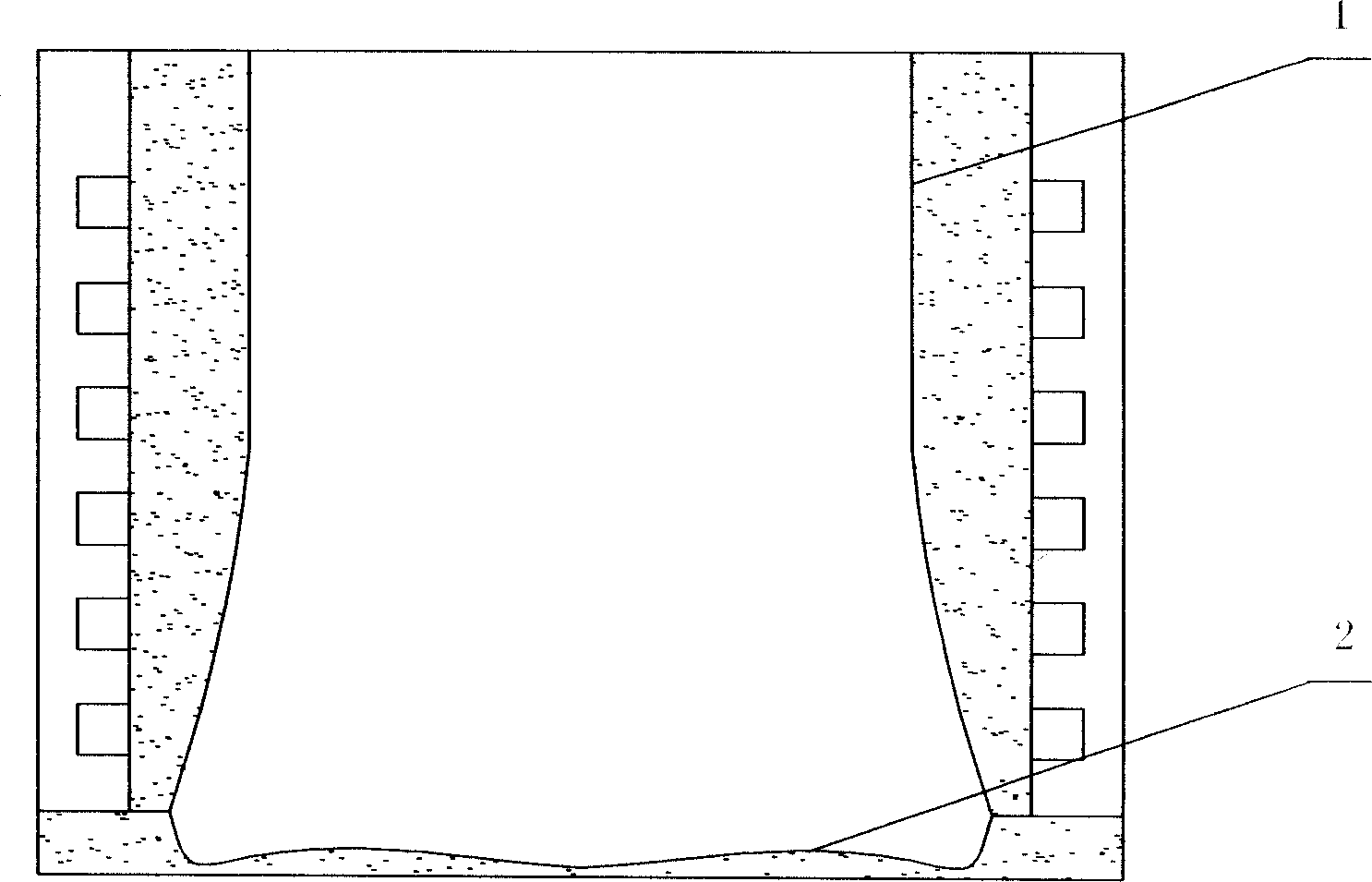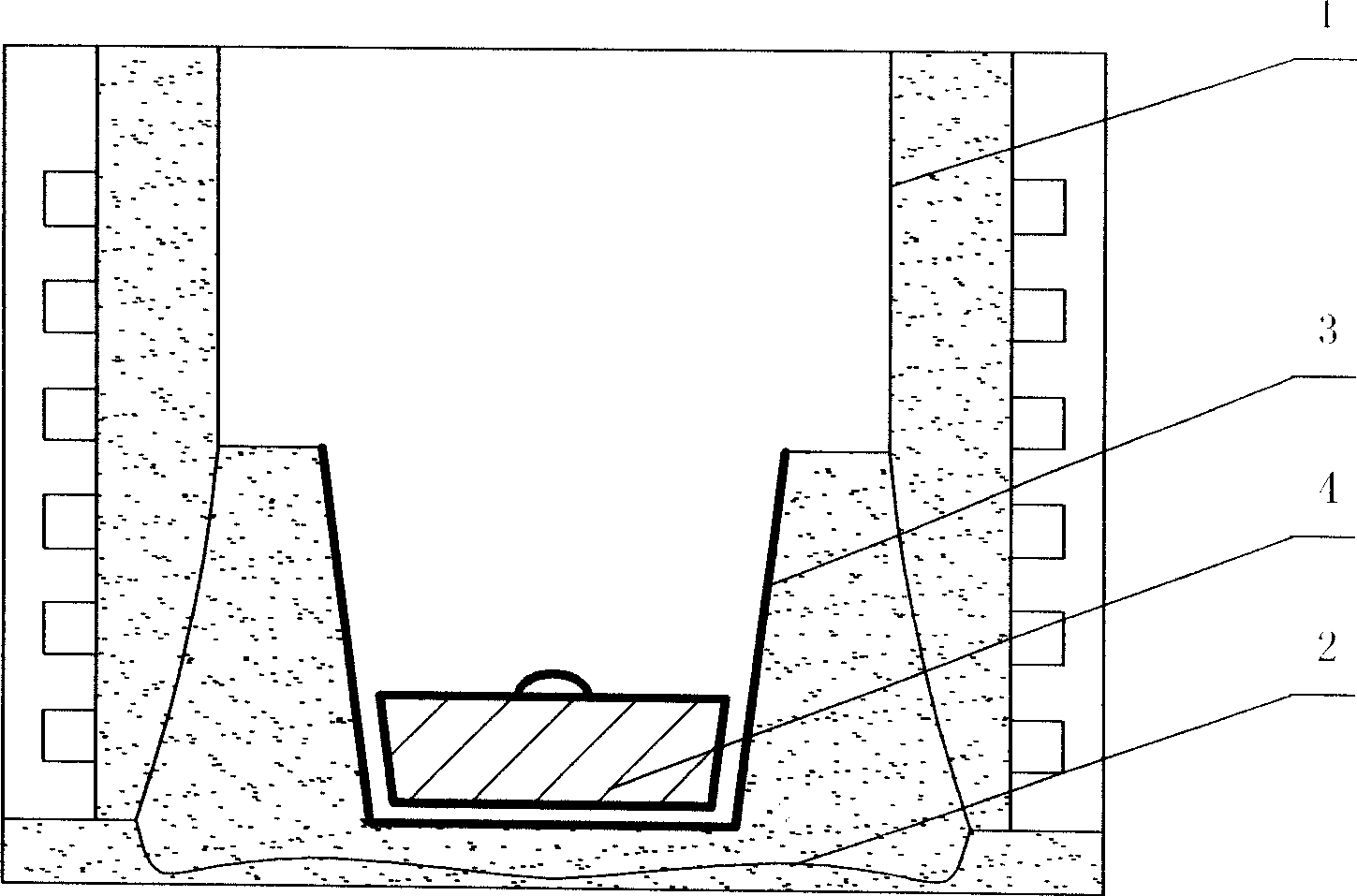Method for repairing furnace lining of intermediate frequency furnace for steelmaking
A technology for furnace lining repair and intermediate frequency furnace, which is applied in the direction of lining repair, furnace, electric furnace, etc. It can solve the problems of time and labor required for furnace lining, difficulty in combining furnace lining with original furnace lining, poor furnace wall repair effect, etc., and achieve sintering effect Good, fast and effective repair, easy to master effect
- Summary
- Abstract
- Description
- Claims
- Application Information
AI Technical Summary
Problems solved by technology
Method used
Image
Examples
Embodiment 1
[0031] Such as figure 1 As shown, usually after 40-50 heats, the furnace lining becomes thinner and fails, often in the shape of an elephant foot. At this time, the obvious characteristics are: the melting speed is obviously accelerated, the liquid level of the molten steel of the same weight is lower than the initial stage by more than 300mm, and the local There are obvious deep recesses, and when it is found that the thickness of the current lining is less than or equal to 40% of the original lining thickness during actual production, the lining can be repaired.
[0032] Pour out all the molten steel in the furnace. If there is any remaining part, wait for it to solidify and remove it, and clean up the residue attached to the furnace. Sprinkle boric acid with a particle size of 1mm evenly on the bottom 2 of the furnace. The thickness of boric acid is controlled at 5mm or according to the weight of boric acid. / Furnace bottom 2 area is 2.0Kg / m 2 Add boric acid, and then put...
Embodiment 2
[0034] When the thickness of the front lining is less than or equal to 40% of the original lining thickness, the lining can be repaired.
[0035] Pour out all the molten steel in the furnace, if there is any remaining part, take it out after it solidifies, and clean up the residue attached to the furnace, evenly sprinkle boric acid with a particle size of 1.5mm on the bottom 2 of the furnace, control the thickness of boric acid at 5.5mm or press Boric acid weight / area of furnace bottom 2 is 2.25Kg / m 2 Add boric acid, and then put in an appropriate amount of quartz sand that is exactly the same as the furnace lining in terms of composition and particle size as the furnace material according to the loss of the second part of the furnace bottom. Furnace mending is put into the furnace with forming steel mold 3, as figure 2 As shown, the forming steel mold 3 is a barrel shape matched with the furnace wall 1, and then a steel block 4 is put into the forming steel mold 3, the si...
Embodiment 3
[0037] When the thickness of the front lining is less than or equal to 40% of the original lining thickness, the lining can be repaired.
[0038] Pour out all the molten steel in the furnace, if there is any remaining part, take it out after it solidifies, and clean up the residue attached to the furnace, evenly sprinkle boric acid with a particle size of 2mm on the bottom 2 of the furnace, and control the thickness of boric acid at 6mm or according to the weight of boric acid / Furnace bottom 2 area is 2.5Kg / m 2 Add boric acid, and then put in an appropriate amount of quartz sand that is exactly the same as the furnace lining in terms of composition and particle size as the furnace material according to the loss of the second part of the furnace bottom. Furnace mending is put into the furnace with forming steel mold 3, as figure 2 As shown, the forming steel mold 3 is a barrel shape matched with the furnace wall 1, and then a steel block 4 is put into the forming steel mold...
PUM
| Property | Measurement | Unit |
|---|---|---|
| particle size | aaaaa | aaaaa |
| particle size | aaaaa | aaaaa |
Abstract
Description
Claims
Application Information
 Login to View More
Login to View More - R&D
- Intellectual Property
- Life Sciences
- Materials
- Tech Scout
- Unparalleled Data Quality
- Higher Quality Content
- 60% Fewer Hallucinations
Browse by: Latest US Patents, China's latest patents, Technical Efficacy Thesaurus, Application Domain, Technology Topic, Popular Technical Reports.
© 2025 PatSnap. All rights reserved.Legal|Privacy policy|Modern Slavery Act Transparency Statement|Sitemap|About US| Contact US: help@patsnap.com


